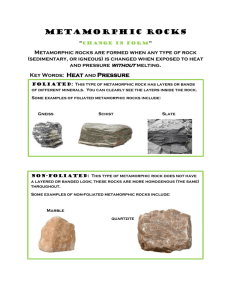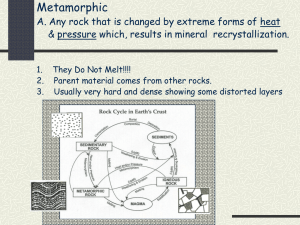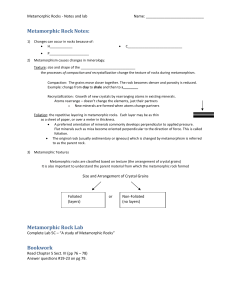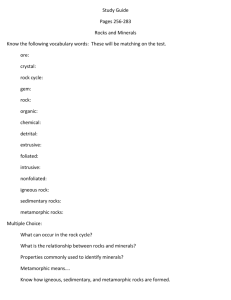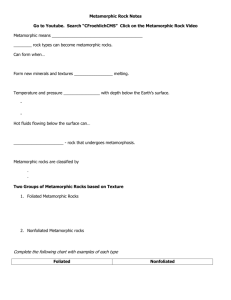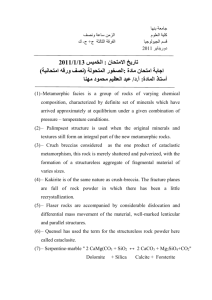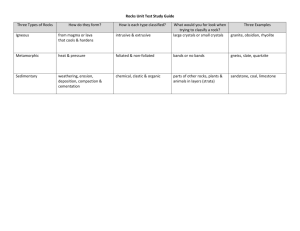Classifying Common Metamorphic Rocks
advertisement
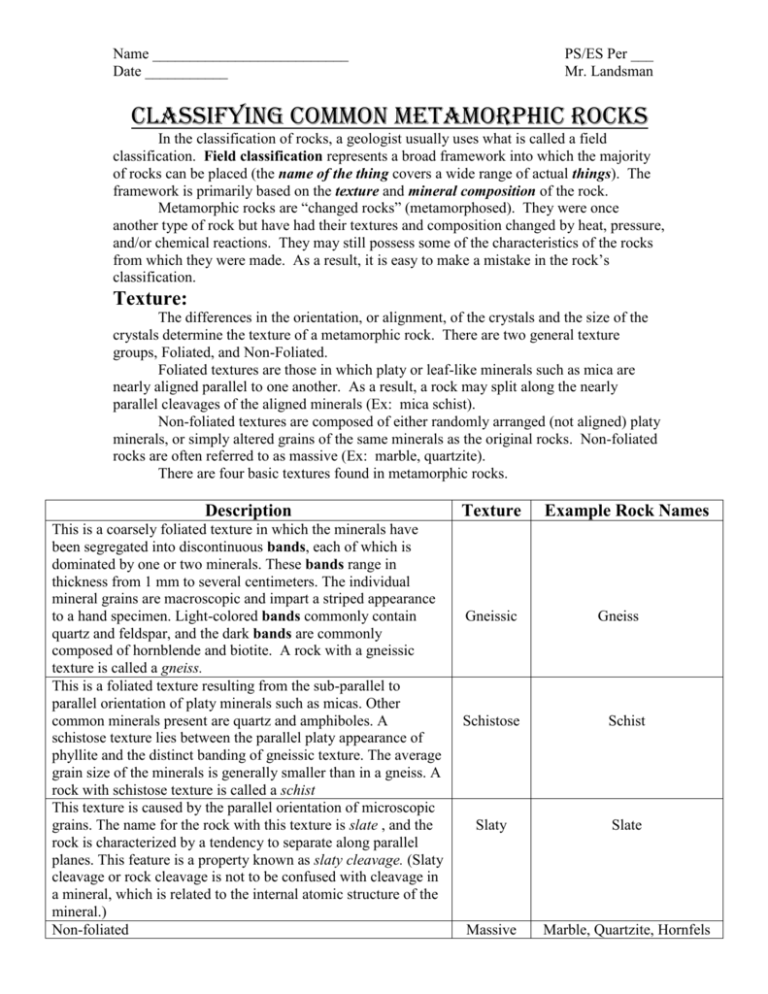
Name __________________________ Date ___________ PS/ES Per ___ Mr. Landsman Classifying Common Metamorphic Rocks In the classification of rocks, a geologist usually uses what is called a field classification. Field classification represents a broad framework into which the majority of rocks can be placed (the name of the thing covers a wide range of actual things). The framework is primarily based on the texture and mineral composition of the rock. Metamorphic rocks are “changed rocks” (metamorphosed). They were once another type of rock but have had their textures and composition changed by heat, pressure, and/or chemical reactions. They may still possess some of the characteristics of the rocks from which they were made. As a result, it is easy to make a mistake in the rock’s classification. Texture: The differences in the orientation, or alignment, of the crystals and the size of the crystals determine the texture of a metamorphic rock. There are two general texture groups, Foliated, and Non-Foliated. Foliated textures are those in which platy or leaf-like minerals such as mica are nearly aligned parallel to one another. As a result, a rock may split along the nearly parallel cleavages of the aligned minerals (Ex: mica schist). Non-foliated textures are composed of either randomly arranged (not aligned) platy minerals, or simply altered grains of the same minerals as the original rocks. Non-foliated rocks are often referred to as massive (Ex: marble, quartzite). There are four basic textures found in metamorphic rocks. Description This is a coarsely foliated texture in which the minerals have been segregated into discontinuous bands, each of which is dominated by one or two minerals. These bands range in thickness from 1 mm to several centimeters. The individual mineral grains are macroscopic and impart a striped appearance to a hand specimen. Light-colored bands commonly contain quartz and feldspar, and the dark bands are commonly composed of hornblende and biotite. A rock with a gneissic texture is called a gneiss. This is a foliated texture resulting from the sub-parallel to parallel orientation of platy minerals such as micas. Other common minerals present are quartz and amphiboles. A schistose texture lies between the parallel platy appearance of phyllite and the distinct banding of gneissic texture. The average grain size of the minerals is generally smaller than in a gneiss. A rock with schistose texture is called a schist This texture is caused by the parallel orientation of microscopic grains. The name for the rock with this texture is slate , and the rock is characterized by a tendency to separate along parallel planes. This feature is a property known as slaty cleavage. (Slaty cleavage or rock cleavage is not to be confused with cleavage in a mineral, which is related to the internal atomic structure of the mineral.) Non-foliated Texture Gneissic Example Rock Names Gneiss Schistose Schist Slaty Slate Massive Marble, Quartzite, Hornfels Using the text above and your ESRT, complete the questions below. 1. The classification of rocks is primarily based on _______________________ and _____________________________ ____________________________. 2. Name the four basic textures of Metamorphic Rocks. a. ____________________________________ b. ____________________________________ c. ____________________________________ d. ____________________________________ 3. Name the eight common classifications of Metamorphic Rocks. a. _____________________________________ b. _____________________________________ c. _____________________________________ d. _____________________________________ e. _____________________________________ f. _____________________________________ g. _____________________________________ h. _____________________________________ 4. Name the rocks that may result from metamorphism of the following “original” rocks. a. Limestone _________________________ b. Sandstone _________________________ c. Granite ___________________________ d. Shale (see notes) _____________________________________________________________ _____________________________________________________________ 5. For each description, indicate the type of metamorphic rock. a. Fine to coarse-grained, positive acid reaction ________________________________________________________ b. Very fine-grained well-foliated, looks like compressed shale ________________________________________________________ c. Coarse-grained with alternating bands of light and dark minerals ________________________________________________________ d. Very hard, sugary-textured, massive, non-foliated, no acid reaction ________________________________________________________ BONUS: What is the correct vocabulary for: a coarsely foliated rock that shows banding and the minerals within the rock break along planes of weak atomic bonds. __________________________________________________
